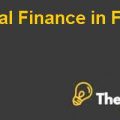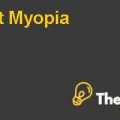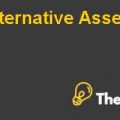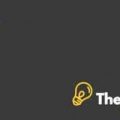
Introduction:
The report presents a case about Polaroid Corporation,which is one of the leading camera producers. Initially, the company enjoyed a monopoly in instant cameras but the emerging trend in digital cameras threatened the profits of the company substantially so in order to tackle this problem, the company developed an extensive plan to achieve strategic success in the long run.
The primary objective of the plan was to develop value creation activities, support financing flexibility and improvements in the investment grade rating of the bond. Further, the plan also consisted to smooth its cost and develop a suitable capital structure; which would enhance the value of the shareholders in the long run.
- 1. Please define the business challenge with qualitative and quantitative analysis.
The company had enjoyed tremendous success over the past few years but the expansion of digital cameras threatened the customer base of the organization significantly because they were moving from instant photography to digital solutions. It caused Polaroid’s Commercial Group to account for approximately half of its total sales and one third of instant film sales. The increased competition from Xerox, 3M and Sony strongly threatened the financial figures of the organization and made the company to report a reduction in sales by (3.27%) in 1995. Further, the net profit margin of the company also decreased from 5.07% in 1995 to (6.27%) in 1996.
Further, annual compound salesgrowth rate of Polaroid was 3.6% in nominal terms but after adjusting for inflation, it virtually became zero. The sales and earnings of Polaroid substantially deteriorated when the instant photography market came to its maturity in the United States. Moreover, the absence of new product introduction caused the firm to report a substantial reduction in P/E ratio from 15.2 in 1995 to 12.1 in 1996.
Moreover, the figures of U.S. and international sales had almost reversed from 1993 to 1995, which caused the company to report a steady growth in the international segment between 3% and 8% per year but on the other hand, sales in the United States had fallen by 2% in 1994.
Further, the company also faced a risk that the company might lose its current credit rating. This could be happen if the company failed to control its debts, so in such cases the credit rating of the company would be threatened, which will tend the organization to suffer increased financial cost. Further, it would have less access to investors and fewer funds to the organization during economic times, which would substantially damage the brand image of the company.
- 2. What are the items and the criteria which Ralph Norood has to consider when he propose a tangible financial policy to CEO and the board members
When Ralph proposed a tangible financial policy to the CEO and the board members so its basic motive was to improve the organization’s performance by exploiting the company’s existing brand by entering into new emerging markets. Further, the plan was also incorporated in order to enhance the organization’s value, financial flexibility and concerns for improving the bond rating of the organization.
The company has notes of $150 million at 7.25%, which attained maturity on January 15, 1997. 8% notes of $200 million were due on March 15, 1999. Further, the loan was taken in 1988 to establish the organization’s leveraged employee stock ownership plan (ESOP), as part of the leveraged recapitalization of the firm. $140 million, which were convertible subordinated debentures at 8% and were convertible to common stock at $32.5 per share. These were not redeemable until September 30, 19998 unless the stock price exceeded $48.75 for 20 to 30 consecutive trading days.
Further, Norood also wanted to improve the capital structure policy of the company, where a combination of debt and equity was selected that would enhance the future potential of the company. In a restructuring policy, the prime motive of the company was to keep the cost of capital low, enhance the firm’s value and enhance the credit rating, so the organization could avail the opportunity to obtain debts at relatively low interest rate and to enhance the investment grade status.
- 3. Regarding each rating category (from AAA to B), please verify the unused debt capacity and the interest coverage (before tax deduction) of Polaroid with quantitatively. In addition please estimate the stock price of Polaroid
Debt capacity refers to the organization’s ability to borrow. It refers to the amount where an organization can borrow up to a specific amount where the organization’s corporate value no longer increases. It involves the assessment of debt than an organization can repay in a timely manner without affecting its financial viability.
Our analysis in Appendices 1 shows that the AAA, AA, A and BBB have an unused debt capacity of $352.67 million, 241.45 million, 153.33 million and 36.33 million respectively, which reflects the bond rating where the organization can repay the ........................
This is just a sample partial case solution. Please place the order on the website to order your own originally done case solution.
Puts students in the shoes of the recently appointed treasurer of Polaroid Corporation, you need to consider a number of issues related to the debt policy of the firm. Concern is the outstanding $ 150 million of 7.25% notes due in a few months. Although investment bankers are interested in doing business with Polaroid trying to present proposals for the return of the issue, the new treasurer of the opinion that any decision to refinance should be part of a broader review of the financial policy of the firm. Accordingly, he has reviewed the general policy of the debt of the company, focusing primarily on a combination of debt and equity and the maturity structure of the debt. Asks students to consider how much business flexibility Polaroid, will require in the future and choose a target debt ratio, which provides the necessary flexibility. Students should assess, in addition to the internal resource requirements, the role of a rating and investment grade status to maintain continued access to capital markets.
This Darden study. "Hide
by Robert F. Bruner, Susan Chaplinsky Source: Darden School of Business 20 pages. Publication Date: April 4, 1997. Prod. #: UV0007-PDF-ENG














